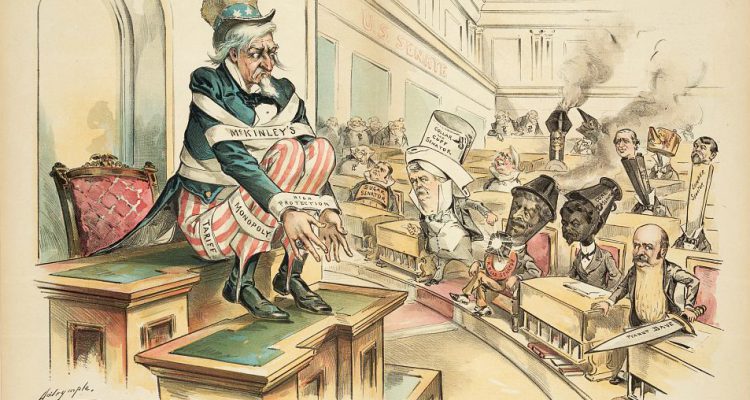By: Patrick W. Zimmerman
Neither house of Congress is particularly adept at legislating, apparently. Depending on your opinion of that august branch of government, that might be a good thing.
It’s pretty clear that the House has a more organized Republican Party, at least as far as it comes to sponsoring and ramming legislation through that chamber (voting, and the posturing that comes with it, is another matter.). So, what about the Upper House, the one that conventional wisdom holds to be a more mature, moderate, deliberative body than the House of Representatives? The chamber which never engages in grandstanding or long-shot political gambles (that sometimes work). No sirree, nothing but adults in this room.
The question
Who has been most effective at getting bills through the Senate, and then enacted as laws, over the last three Congresses (~5.5 years)?
The short-short version
As in the House, no one has been particularly effective, but the Republican Party has been less bad. The Republican advantage is less pronounced than in the House.
This is pretty much as expected in an environment where the Republicans have held both houses most of the time (the 113th Congress was the lone exception, with a Democratic Senate and a Republican House). There’s actually a mild correlation in the Senate between being more conservative (higher DW-Nominate score) and enacted percentage: R2=0.4 (this is stronger than the effect in the house, where there’s an R2 of 0.23).
The average Republican Senator’s bills passing the upper house 18.9% of the time compared to the average Democratic / Independent senator getting 13.4% of his or her bills through the Senate. Overall, 3.2% of Democratic-sponsorships turn into laws, and 5.4% of Republican ones do.
Individually, the star performers are two middle-of-the-road Republicans: outgoing Tennessee Senator (and vocal Trump critic) Bob Corker and the Senior Senator from Alabama (33.1% of cosigned bills passed, 8.6% became law), Richard Shelby (32.8% of cosigned bills passed, 7.6% became law). No one else in either party is within 6% of their pass rate, and Corker also leads in enacted rate (though by a thin 0.9% margin over Mitch McConnell).
The top Democrat in both categories, centrist Joe Donnelly (D-IL), only ranks 13th in Senate Passage percentage (22.0%) and 15th in law enacted percentage (6.2%).
What’s the take-home? That the most powerful man in Washington, as far as choosing what ideas become codified into law, is probably Mitch McConnell. Feel free to barf at that thought.
Efficiency at getting bills through the House
Mouseover for details.
Much like in the House, the Democrats’ minority status (yes, we’re lumping Bernie Sanders and Angus King in here) makes it pretty tough sledding for them. On bills that Democrats succeed at getting through the Senate, they always need at least one or two Republican votes. The most likely candidates are, as expected, Susan Collins, Lisa Murkowski, or Shelly Moore Capito, the three Republican diamonds split off from the main group towards the center.
After applying a Mann-Whitney U test, the Republican advantage is significant at p < 0.00001 (U=425.5, z-score 6.01154, two-tailed).
Efficiency at getting bills enacted as laws
Mouseover for details.
Intuitively, if the Republicans are more effective at using their majority to get bills through the Senate, they’re also better at getting them signed into law.
After applying a Mann-Whitney U test, the results were significant at p < 0.00001 (U=295.1, z-score 6.88335, two-tailed).
What bills has each rep cosponsored?
Want to know what certain Senators have been doing? Search or pick a name from the drop-down list.
Mouseover for details.
Methodological minutiae
First, as with all of our legislative projects, a big shout out goes to ProPublica’s Congress API, which I used to pull all the data on legislation and individual representatives. I first pulled a list of all 54 members of the 115th Congress (some seats have changed hands due to retirement or a Senator being pulled to serve in the Executive Branch), then chopped up the resulting json with a bash script and jq to create a simple text list of legislator IDs. I then used that list to pull all legislation sponsored or cosponsored by each legislator, going back to the 113th Congress (which is as far back as the API’s bills endpoint goes), which got chopped up by another bash script using jq to produce a nice big .csv file.
Then, I imported it into a MySQL database to merge the member and legislation data and calculate all the percentage score, then re-exported it to a .csv that Tableau can use to make dashboards (above).
What’s next
Are there clear communities within our Senate? And how have those communities changed over time? There certainly are some interesting ones in the House, so it seems logical. Let’s go find out.

No Comments on "Even fewer bills get through the Senate than the House"